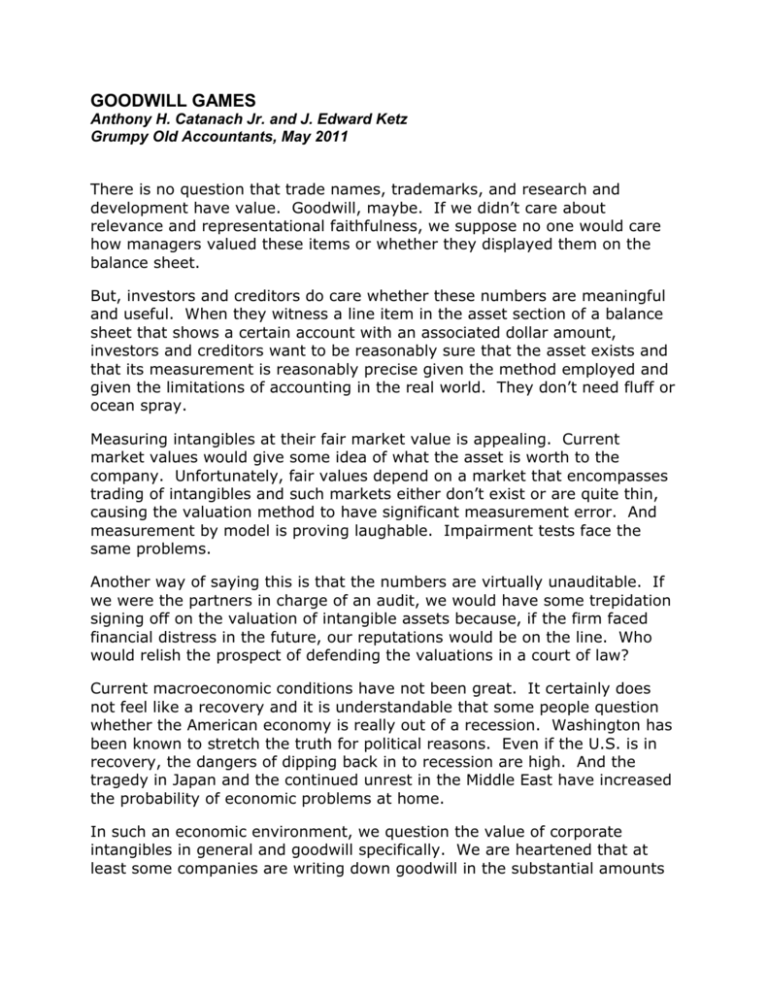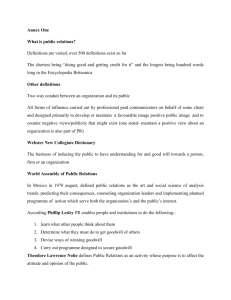(May) Goodwill Games
advertisement

GOODWILL GAMES Anthony H. Catanach Jr. and J. Edward Ketz Grumpy Old Accountants, May 2011 There is no question that trade names, trademarks, and research and development have value. Goodwill, maybe. If we didn’t care about relevance and representational faithfulness, we suppose no one would care how managers valued these items or whether they displayed them on the balance sheet. But, investors and creditors do care whether these numbers are meaningful and useful. When they witness a line item in the asset section of a balance sheet that shows a certain account with an associated dollar amount, investors and creditors want to be reasonably sure that the asset exists and that its measurement is reasonably precise given the method employed and given the limitations of accounting in the real world. They don’t need fluff or ocean spray. Measuring intangibles at their fair market value is appealing. Current market values would give some idea of what the asset is worth to the company. Unfortunately, fair values depend on a market that encompasses trading of intangibles and such markets either don’t exist or are quite thin, causing the valuation method to have significant measurement error. And measurement by model is proving laughable. Impairment tests face the same problems. Another way of saying this is that the numbers are virtually unauditable. If we were the partners in charge of an audit, we would have some trepidation signing off on the valuation of intangible assets because, if the firm faced financial distress in the future, our reputations would be on the line. Who would relish the prospect of defending the valuations in a court of law? Current macroeconomic conditions have not been great. It certainly does not feel like a recovery and it is understandable that some people question whether the American economy is really out of a recession. Washington has been known to stretch the truth for political reasons. Even if the U.S. is in recovery, the dangers of dipping back in to recession are high. And the tragedy in Japan and the continued unrest in the Middle East have increased the probability of economic problems at home. In such an economic environment, we question the value of corporate intangibles in general and goodwill specifically. We are heartened that at least some companies are writing down goodwill in the substantial amounts we think appropriate. Eastman Kodak, for example, wrote down its $1,681 million of goodwill by $785 million. That looks realistic. On the other hand, we tire of companies such as Dex One, which focus on EBITDA instead of GAAP because GAAP involves write-downs of intangibles. Former SEC Chief Accountant Lynn Turner once referred to EBITDA and similar measures as “everything but the bad stuff.” He was correct, and managers need to accept the fact that expenses and losses belong on the income statement just as much as revenues and gains. Another example is Kenexa, which not only adds back goodwill impairment but also quite a few other negative accounts. You might as well play these games when your retained earnings is a deficit. We also tire of companies like Federal Signal who refer to goodwill as a noncash charge. If one is wearing tightly fitting blinders, yes, goodwill writedowns do not involve cash disbursements, but that is a misleading observation. Goodwill involves cash disbursements when the corporation acquires other firms and pays top dollar for these acquisitions, perhaps even paying too much. At any rate, the acquisition of goodwill requires cash disbursements directly or indirectly via the issuance of stock. We find interesting the case of Dicks Sporting Goods, which recorded $111.3 million goodwill in 2007 because of its acquisition of Golf Galaxy. In 2009 it revalued its goodwill and “based on macroeconomic factors” decided that the goodwill was worthless. It took a charge for the full $111.3 million in 2009 and suggests that it paid too much for Golf Galaxy. We wonder how many firms should have done this in their 2010 annual reports. Given asset values in the market place and given carrying amounts for goodwill, we think quite a few should have. It remains debatable whether goodwill is really an asset, but if it is, one must be careful in its measurement. We are skeptical about the balance sheet values of intangibles assets, especially for goodwill. Maybe it is time to recognize the precariousness with which these assets are measured and either write them off immediately or amortize them over a short period of time, such as five years. This essay reflects the opinion of the authors and not necessarily the opinions of The Pennsylvania State University, The American College, or Villanova University.




![Quiz chpt 12 13 Fall 2009[1].doc](http://s3.studylib.net/store/data/008065145_1-9341d7c32393454ecadd4d67922dfd05-300x300.png)